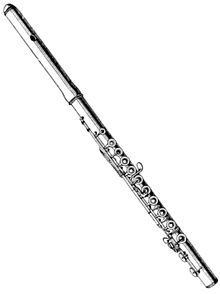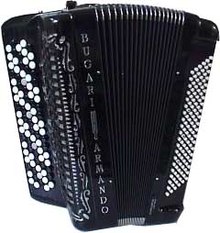Aerophone
Aerophones (from the Greek ἀήρ , “air” and φωνή “sound”; literally “air sounder”) are all musical instruments in the Hornbostel-Sachs system of 1914 that produce the sound by directly stimulating the air to vibrate. They are divided into:
- (actual) wind instruments in which the vibrating air is limited by the instrument, and
- free aerophones in which the vibrating air is not restricted by the instrument.
The distinction according to the tone generation follows in the scheme of Hornbostel and Sachs on the next level.
Classification according to the tone generation
Distraction Aerophones
The air flowing past is split and modified in such a way that sound is generated. In the case of free deflection aerophones, the oscillation caused by the refraction of the air is not limited by an instrument body. This includes the real whip .
Interrupt aerophones
In the case of interruption aerophones, the air flowing past is regularly interrupted, causing sound to be generated.
Most interruption aerophones are self-sounding , that is, the airflow itself moves the element that regularly interrupts the airflow. These include tongue aerophones: In instruments with tongues , the air flowing past is regularly interrupted by the vibrations of the tongue. There are tongue aerophones with a penetrating tongue, e.g. B. Accordion and Harmonica .
In the case of non-self-sounding interruption aerophones, the interrupting element is not moved by the air flow itself. These include the buzzing stick , the purr and the siren .
Explosive aerophones
The air is compressed once. One example is the children's toy slam gun. Even with a whip , the bang is created by compressing the air at the end of the belt.
Actual wind instruments
- Air reed instruments (blade instruments): With flutes , an air stream is guided over an edge that divides the air stream and modifies it so that sound is generated . With transverse flutes , the edge is that of a side blowhole, with rim-blown flutes, which include panpipes , the leading edge of the tube. The recorder uses labial pipes with a fixed blowing edge in the air stream.
- Reed instruments with single reed (opening tongue), e.g. B. saxophone and clarinet
- Reed instruments with double reed (counter-hammer), e.g. B. oboe and bassoon
- Trumpet instruments (lip-tone aerophones) or brass instruments . With them, the air flow makes the human lips vibrate and is regularly interrupted by them. Examples are the zinc and the trumpet .
- In the case of the Membranopipes , a membrane interrupts the flow of air. When the air pressure is increased, the membrane periodically allows air to escape through an opening that keeps it closed when it is idle.
According to their shape, sucked trumpets are trumpet instruments , but the sound is created with the lips by sucking in air. Membranopipes and Sucket trumpets are not included in the original Hornbostel-Sachs system.
Web links
- Erich Moritz von Hornbostel , Curt Sachs : Systematics of musical instruments. One try. In: Zeitschrift für Ethnologie, Volume 46, Number 4–5, 1914, pp. 553–590 ( Textarchiv - Internet Archive )

